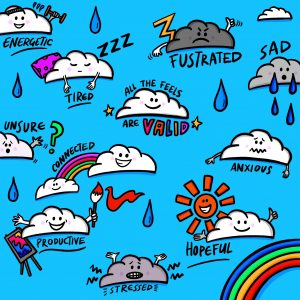By Vijay Tailor-Hamblin,
This was a very different YPAG meeting to normal – it was held via Zoom as a remote meeting because social distancing means we could not all travel to London. It was quite strange at first as we were all a bit quiet, but we soon warmed to it. We started off by saying hello and answering a poll about how our ‘weather’ was:

(Picture © Beci Ward: check out the great Covid-related colouring pages on her website)
In the first half, we discussed the logo for the group with Sofie, the artist who we’ve been working with, and used a poll to decide which one of our top three we liked best. We decided on the first ‘swoosh’ design:
After this, we talked about the ground rules we’d come up with at the last meeting and tried to improve them. We did this in small groups, then brought all our ideas together again. We merged some of the rules as they were similar. We decided that maybe we should make one list of rules instead of two.
During the second half, a researcher (James) zoomed in and told us about genetic eye disease and how he was doing research to help prevent it. He showed us the different types (including videos of eye surgery!) and explained how it is caused by spelling mistakes in your DNA. We answered his questions and looked at his information leaflets to make them easier and more understandable for children asked to take part in the project. It was really interesting.
It was a fun meeting, especially because it was virtual. We’re planning some more Zoom meetings soon.
The researcher who came to our meeting said: “My research looks at genetic disorders of the blood vessels in the retina. The aim of my research is to clarify which spelling mistakes in which gene are causing each condition. With this knowledge I then plan to develop treatments that can be injected into the eye to correct the spelling mistakes. I found the YPAG to be a very well informed and enthusiastic group with a clear interest in research. Some members had taken part in research before and I found listening to their experiences very interesting. The YPAG gave quite a lot of useful feedback about how they would redesign the children’s’ patient information sheets for my project. This will help the information sheets to be more suited to the needs of children who are invited to enrol in the study. The group also said that they would like to have the opportunity to meet other children involved in the project and we will try to make that happen.”
Note from the facilitators: We made the meeting shorter than normal (2 hours with a break) and most people agreed in the post-meeting evaluation that this was the right length. Not everyone wanted to take part in the Zoom meeting so group members who opted out were able to take part by email instead.